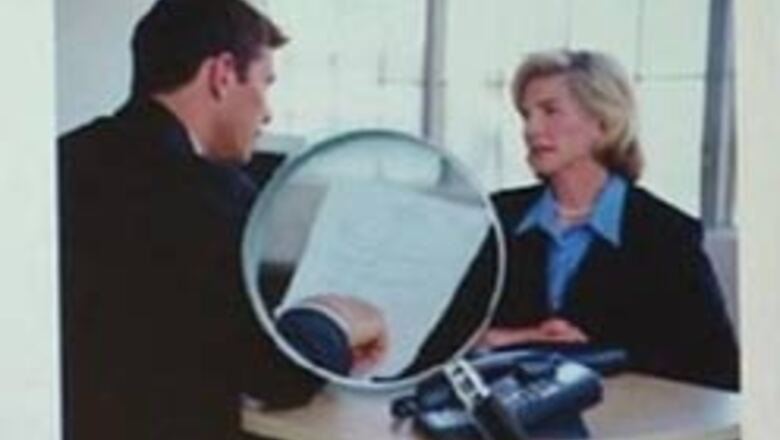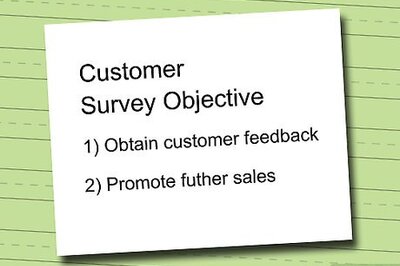
views
With the cutthroat competition today, your resume is the one chance you get to make a good impression. So you must make sure it is flawless. A couple of minor mistakes may cost you your most wanted job.
Find out some of the most common errors in resumes and how you can avoid them.
1. Spelling errors, typos and grammatical errors
Such errors are a big turn off to a prospective employer. He is likely to believe that if you can make mistakes in crucial document like your resume you will probably make more mistakes while you're on the job.
What To Do
If you are not confident of a spelling, look it up in the dictionary. Once you are done writing your resume use the Spell Check tool, but remember it is not a fool proof method. It may not catch every error.
Then again just because everything is spelt correctly it doesn't mean everything is used correctly. Always try to use simple language and if you are not sure of something look it up or verify it from an expert.
The only way to avoid technical and careless errors like mistyping a word or missing a letter or a number is to proof read. After you have checked your resume, ask a family member or friend to proof read it for you.
Remember, nearly every job requires that applicant has good verbal and written communication skills.
Try getting help from a professional resume if you are unable to do it on your own.
PAGE_BREAK
2. Lengthy resume
A long drawn-out resume that runs into four A4 sheets is just ridiculous.
Did you know an average resume is read in seven seconds? In those few seconds, the hiring manager will skim through your entire document and determine if you possess the qualifications needed for the job. Most often an employer will not bother going through such a long resume and you could miss an opportunity you have been waiting for.
What To Do
A regular person's resume should be not more than two pages long, typed in Arial font size 10.
Provide the necessary information and leave out the rest. Your resume should feature educational qualifications and work experience that is relevant to the job you are applying for.
Additional information like your hobbies and your extra curricular activities are futile. Resumes have to be focused and concise, not too wordy with passive sentences.
But in your efforts to keep the resume short and to the point, don't miss out any crucial information. Give out information about your skills and aspirations that will convince the employer to hire you.
Don't forget to enclose a cover letter with your resume. It gives you the opportunity to grab your employer's attention by introducing yourself and stating the job you are applying for.
PAGE_BREAK
3. Non-reader friendly resume
Sometimes applicants use a very complicated layout or style to stand out. But the truth is that the best way to stand out from the crowd is with quality content and a clearly written, neat, error-free document.
What To Do
- Keep the formatting constant throughout. For example, if one header is bold, make sure the others are too.
- All tabs should be in line otherwise the resume will look shabby.
- Use the same font style and size throughout preferably. Also avoid italicizing your resume wherever you feel like it.
- Keep creativity and colour to the minimal.
- Avoid the paragraph format wherever possible and go for bulleting. A bulleted resume is more reader friendly.
Tailor make your resume to suit the requirements of the job you are applying for. For instance, if you are a journalist applying for a copy editor position, make sure to include your copy editing experience.
Also include certain keywords that have been mentioned in the requirements. If you are into programming, mention words like PHP, Javascript etc. if that is what is required.
PAGE_BREAK
4. Unorganised resume
The information in your resume should be listed in order of importance to the reader.
What To Do
Your format should start with your basic personal information like name, date of birth, address and contact information. You can then go on to your career objective and educational qualifications.
After that should be your past work experience with your job title or job positions along with the corresponding dates and accomplishments or achievements if any.
If you are copying and pasting your resume from a Word document into a Plain text format on a job site, make sure to check the formatting. It tends to get messed up.
5. Insufficient contact information
This is a very common problem faced by every organization.
If an organisation needs to contact you and the contact information provided by you is wrong or not enough your most desirable job is out of reach even if you deserved it.
What To Do
Just like you update your resume, update the contact information in it too. If your cell phone number has changed change it in your resume. Also double check the number to make sure the number of digits is right etc.
Always provide two to three ways of contacting you. You could give a landline number, your cell phone number and an E-mail id. Double check all the information you are providing.
Avoid complicated or ostentatious email ids like [email protected] in your resume. You must have an email id specially made for such official purposes. Also provide the email id which you check often not a deactivated one.
If you are applying for a job via a consultant, you could include your contact information at the end rather than the beginning. This is because the consultant is likely to remove the information so that the employer contacts them first. It might mess with your formatting.
PAGE_BREAK
6. Too much personal than professional information
Some people give a passport size photograph along with their resume and include information like their height, weight, age, martial status, number of children, passport number etc. Kindly note you are not applying to a matrimonial column or a personality contest.
You are applying for a job where the employer is looking for professional achievement that will help him judge whether you are suitable for his company or not.
What To Do
Cut down on the personal information and talk more about how you made a difference to your previous company. Do not talk about your duty or your designation. Talk about your accomplishments and how you overcame the challenges you faced. Also specify certain actions or tasks which set you apart from the rest
Your resume should be more accomplishment driven than duty driven. Remember the employer is looking for someone who has the required experience in the field.
If you are a graphics designer or a photographer, providing a link to your online portfolio is a very good idea.
7. Red flag information
Information such as being fired or employment gaps or confessing health or performance problems tell poorly on you and will make the employer wary of hiring you.
What To Do
A resume does not ask you to state your reasons for leaving your previous companies. So don't do that. Just mention from when to when you were working in each company.
If you discontinued your job in order to pursue further studies mention that clearly otherwise it will be taken as a break in your career.
Never state your salary information or mention about your salary expectations or your requirements from the job.
PAGE_BREAK
8. Invalid references
You are required to furnish two references of people that will vouch for you. However, this does not mean you put the name of a family member or friend unless of course you have worked in that person's company or that person was your senior at some point.
What To Do
Provide two references of people who you have worked with and who you know will vouch for you if contacted. So you definitely cannot put your current employer's name and contact details. After all, you are planning to quit.
Do not put any colleague's name. The person must be someone who you have reported to. In case of a sales person, you could put the name of a client.
If you are a fresher, you could provide one reference from your educational background and one professional.
Important rules to follow:
- When stating your education qualifications or your previous company's name or university's name, write the full name, not abbreviations or short forms.
- While giving quantitative information spell out all the numbers from one to nine do not write them in digits.
- Always spell out the word percent. When describing past job duties and experiences in a resume. For instance, when you mention 'I increased sales by 20 per cent', avoid the per cent symbol all together.
- Always include dates for your education or your past job experiences.
- You should have your resume ready in soft copy as well as hard copy. Nowadays there are many companies who search for applicants and download their resumes from job portals. So your resume should be available in all formats and you should upload it in read only format so that the settings do not change.
So pay a little more attention to your resume and you could be one step closer to your dream job!




















Comments
0 comment